The latest census in Scotland took place on 27 March 2011. The census has collected information about the population every 10 years since 1801 (except in 1941 when no census was taken due to the Second World War).
Detailed statistics from the census describe the characteristics of an area, such as how many males and females there are, their ages, ethnic group, education level and a broad range of other characteristics. The statistics are used to understand the increasingly diverse nature of Scotland's population by capturing the similarities and differences in the populations' characteristics locally and nationally. This information underpins the allocation of billions of pounds of public money each year to provide services like education, transport and health.
The 2011 Census achieved an overall response rate of 94 per cent of the usually resident population of Scotland, and over 90 per cent in all council areas. The population estimate for Scotland of 5.3 million is estimated with 95 per cent confidence to be accurate to within +/- 85,000 (0.15 per cent).
Scotland's population on census day 2011 was estimated to be 5,295,000, the highest ever recorded in a census. In the 10 years since the 2001 Census, the population has increased by 233,400 (5 per cent). There were more females (2,728,000 or 51.5 per cent) than males (2,567,000 or 48.5 per cent), and for the first time in any census there were more people aged 65 and over than aged under 15.
Some 4 per cent of the population of Scotland in 2011 were from minority ethnic groups, an increase of two percentage points since 2001 (Figure 9.1). The Asian, Asian Scottish or Asian British population accounted for 3 per cent of the total population in 2011, an increase of 1 percentage point compared to 2001. Just over 1 per cent (1.2 per cent or 61,000) of the population recorded their ethnic group as 'White: Polish'. For the first time, a 'White: Gypsy/Traveller' response category was added in 2011. There were 4,200 people who recorded their ethnic group in this category (0.1 per cent of all people in Scotland).
Ninety-three per cent of the people in Scotland stated that they were born within the UK, a decrease of three percentage points since 2001. Eighty-three per cent of the population were born in Scotland, 9 per cent in England, 0.7 per cent in Northern Ireland and 0.3 per cent in Wales.
Of the 7 per cent (369,000) of people in Scotland who were not born in the UK, 15 per cent (55,000) were born in Poland, and 6 per cent (23,000) were born in each of India and the Republic of Ireland.
Just over two-thirds (69 per cent) of people living in Scotland who were not born in the UK were of working age (16-64 years old) when they arrived in the UK (Figure 9.2). Over half (55 per cent) of people living in Scotland who were not born in the UK arrived between 2004 and March 2011 (likely due in large part to the accession of countries into the European Union between 2004 and 2011).
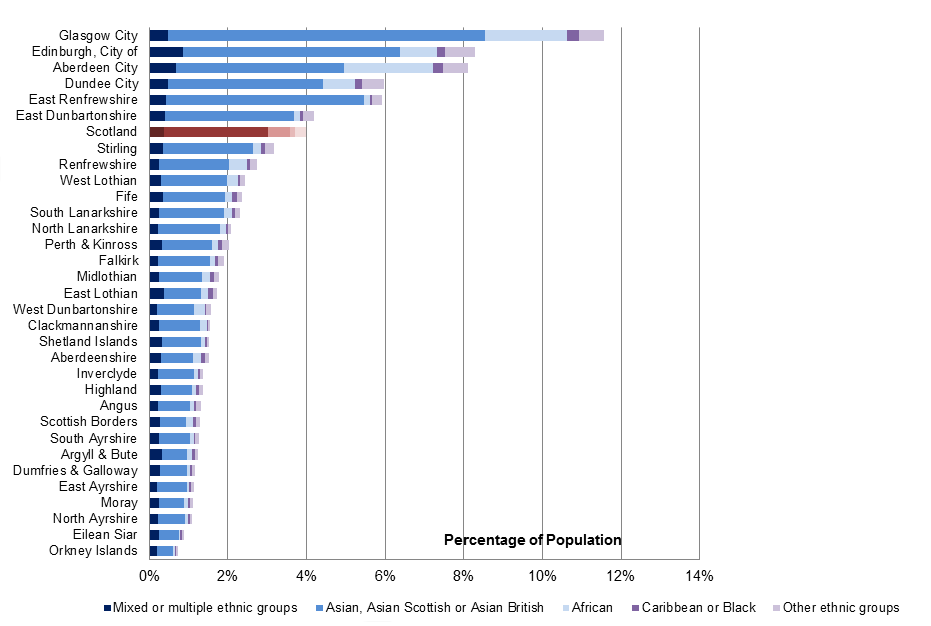
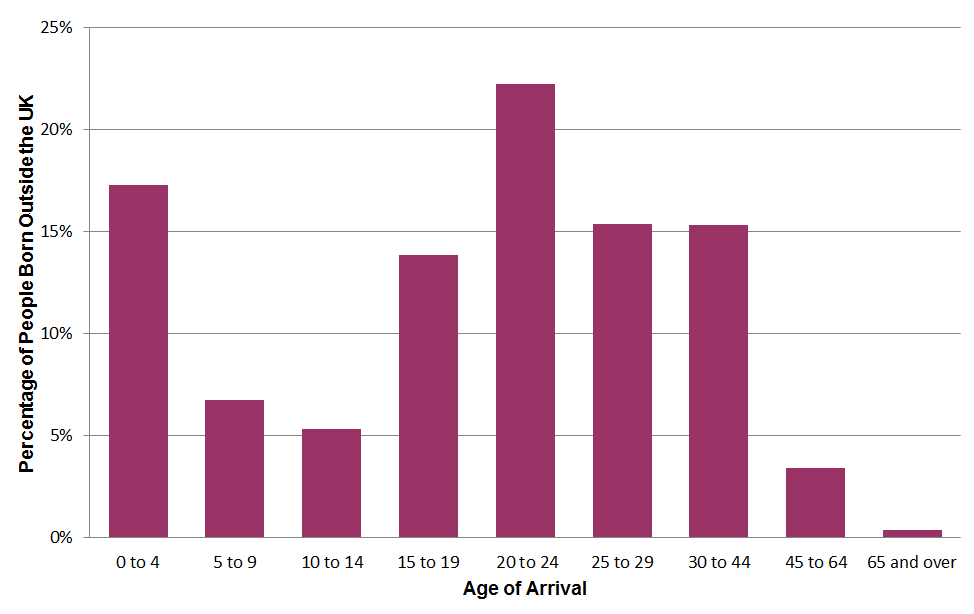
A majority (83 per cent, 4.4 million) of the population of Scotland stated that they felt they had a Scottish national identity, either as the only national identity they felt they had or as one of several national identities. Over 62 per cent of people felt Scottish only, 18 per cent reported they felt both Scottish and British and a further 2 per cent felt they were Scottish in combination with some other identity.
Eight per cent of people felt that they only had a British national identity, 2 per cent felt English only and 2 per cent felt they had some other combination of UK identities (excluding Scottish). The remaining 4 per cent felt they did not have any UK national identity.
Nearly all (98 per cent) of the population aged 3 and over in Scotland reported they could speak, read, write or understand English, with 92 per cent reporting that they could speak, read and write English.
Ninety-three per cent of the population aged 3 and over in Scotland reported that they spoke only English at home. Scots and Polish (each 1 per cent) and Gaelic (0.5 per cent) were the most common languages other than English reported as being used at home. British Sign Language was used at home by 13,000 people aged 3 and over (0.2 per cent of the total population aged 3 and over).
Just over one per cent (73,000) of people aged 3 and over in Scotland were reported as being unable to speak English well or at all.
The total number of people aged 3 and over able to speak Gaelic was 58,000 (or 1.1 per cent of the population), which was a slight fall (of 0.1 percentage point) compared to 2001. There were small increases in this proportion for those aged under 20.
For Scotland as a whole, 30 per cent (1.5 million) of the population aged 3 and over reported they were able to speak Scots.
Over half (54 per cent) of the population of Scotland stated their religion as Christian in the 2011 Census, a decrease of eleven percentage points compared to the 65 per cent recorded in the 2001 Census. Over the same period, there was an increase of nine percentage points in the proportion of the population reporting 'No religion', from 28 per cent to 37 per cent.
In terms of the Christian denominations, there was a decrease of ten percentage points in the proportion of the population who stated they belonged to the Church of Scotland, from 42 per cent (2.1 million) in 2001 to 32 per cent (1.7 million) in 2011. People who stated they were Roman Catholic represented 16 per cent (0.8 million) of the population in 2011; this was the same proportion as in 2001. The 'Other Christian' group accounted for 6 per cent (0.3 million) of the population in 2011, compared with 7 per cent (0.3 million) in 2001.
Just over one per cent (1.4 per cent or 77,000 people) reported that they were Muslim, an increase of 0.6 percentage points since 2001. The number of people reporting as Buddhists, Hindus and Sikhs together accounted for 0.7 per cent of the population in 2011 in total, and all increased from 2001 to 2011. The number of people reporting as Jewish has declined slightly, to just under 6,000.
The majority (82 per cent) of the population stated that their health was either good or very good. The proportion of people in Scotland with a long-term activity-limiting health problem or disability was 20 per cent, the same as reported in 2001. Seventy per cent of the population in Scotland did not record any long-term health condition.
Of the 30 per cent of the population who reported they had one or more types of long-term health condition, the most common category of long-term health condition was 'Other Condition' (19 per cent of the population, 988,000), followed by 'Physical disability' and Deafness or partial hearing loss' which each affected 7 per cent of the population (355,000 and 351,000 people respectively) (Figure 9.3).
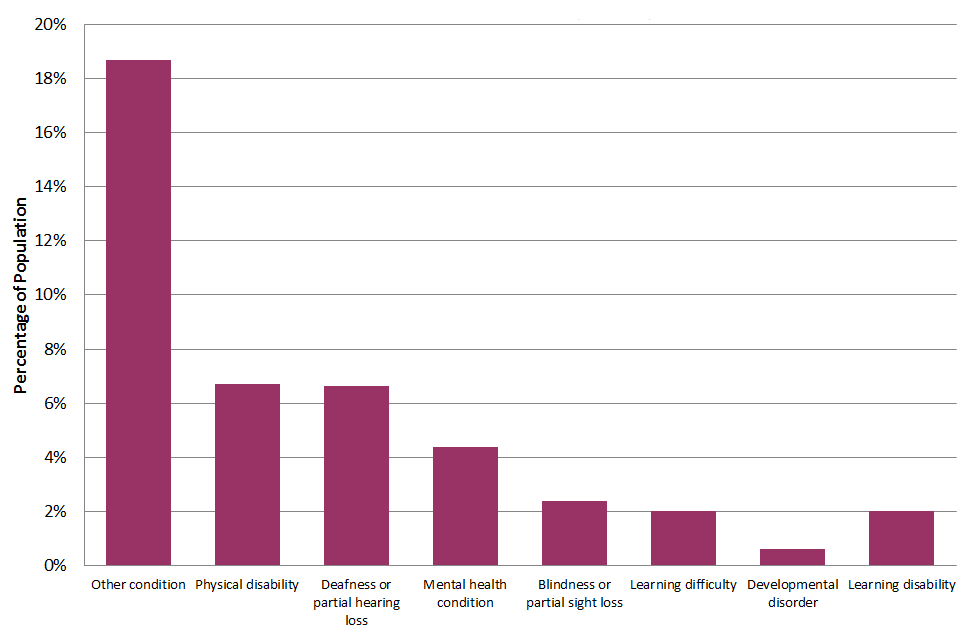
The proportion of people providing unpaid care to family members or friends in 2001 was 9 per cent (0.5 million), similar to the proportion in 2001. Of this group, 44 per cent (219,000) were providing 20 or more hours of care a week, an increase of seven percentage points since 2001, with 27 per cent (132,000) providing 50 or more hours of care a week, an increase of three percentage points since 2001.
The number of households with at least one usual resident recorded in the 2011 Census was 2,373,000, the highest ever. This represented an increase of 8 per cent (181,000) compared with 2001. Between 2001 and 2011 the percentage increase in households was higher than the increase in people in households in all areas of Scotland. This led to a decrease in average household size from 2.27 people per household in 2001 to 2.19 in 2011. In 1961, one-person households were the least common household type. However, by the time of the 2011 Census they had overtaken two-person households to be the most common household type, accounting for 35 per cent of all households.
Just over a third (34 per cent or 811,000) of households were living in purpose-built blocks of flats or tenements, 23 per cent (541,000) lived in semi-detached properties and 22 per cent (520,000) in detached properties. Nineteen per cent per cent (442,000) of households lived in terraced accommodation, a decrease from 20 per cent (444,000) in 2001. The council areas containing large cities contained the highest proportion of households in purpose-built flats or tenements. Higher proportions of households in detached properties were found in the more rural council areas.
Based on information provided by census enumerators on properties for which no census questionnaire was returned, it is estimated that there were 101,000 unoccupied household spaces in Scotland in 2011, 4 per cent of the total of 2.5 million household spaces. Of these unoccupied household spaces, 64 per cent (64,000) were assessed as being vacant, for example new builds or other accommodation awaiting new occupants, and 36 per cent (37,000) were classed as second or holiday homes.
In 2011, there was an average of 5.0 rooms per household and 2.3 rooms per person in Scotland. Data from 1861 shows that 150 years ago there were almost two people (1.7) for every room in a household.
In 2011, 9 per cent (214,000) of households in Scotland had an occupancy rating of -1 or less (including 2 per cent (46,000) with an occupancy rating of -2 or less), implying that they are overcrowded in relation to the notional number of rooms estimated as being required by those living there. In contrast, 66 per cent (1.6 million) of households in Scotland had an occupancy rating of +1 or more (including 38 per cent (904,000) with an occupancy rating of +2 or more), implying that they were under-occupied in relation to the notional number of rooms required by those living there.
Since 2001, the proportion of households with an occupancy rating of -1 or less decreased by three percentage points from 12 per cent (257,000) of households in 2001, while there was an increase of four percentage points in the proportion of households with an occupancy rating of +1 or more, from 62 per cent (1.4 million) in 2001 (Figure 9.4).
The proportion of households people who owned their accommodation was similar in 2001 and 2011, at around 62 per cent. However, while this overall proportion had changed little, there was a five percentage point increase between 2001 and 2011 (from 23 per cent to 28 per cent) in the proportion of households who owned their own home outright, offset by a five percentage point decrease (from 39 per cent to 34 per cent) in the proportion of households who owned their own home with a mortgage or loan. The proportion of households renting their accommodation from a council or housing association fell by five percentage points, from 29 per cent in 2001 to 24 per cent in 2011. The proportion of households in the private rented sector (including living rent free) increased by from 8 per cent in 2001 to 14 per cent in 2011 (Figure 9.5).
Almost all (98 per cent) of households reported they had some form of central heating in the 2011 Census, up from 93 per cent in 2001. In most council areas, gas central heating was the most common type, used by an average of 74 per cent of households. The only exceptions to this were the Shetland Islands and Orkney.
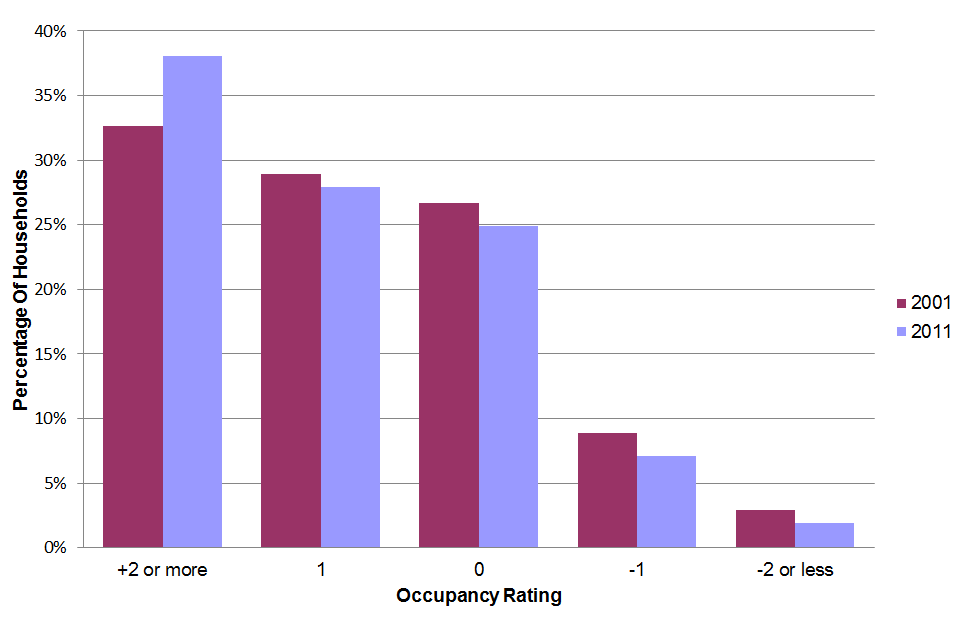
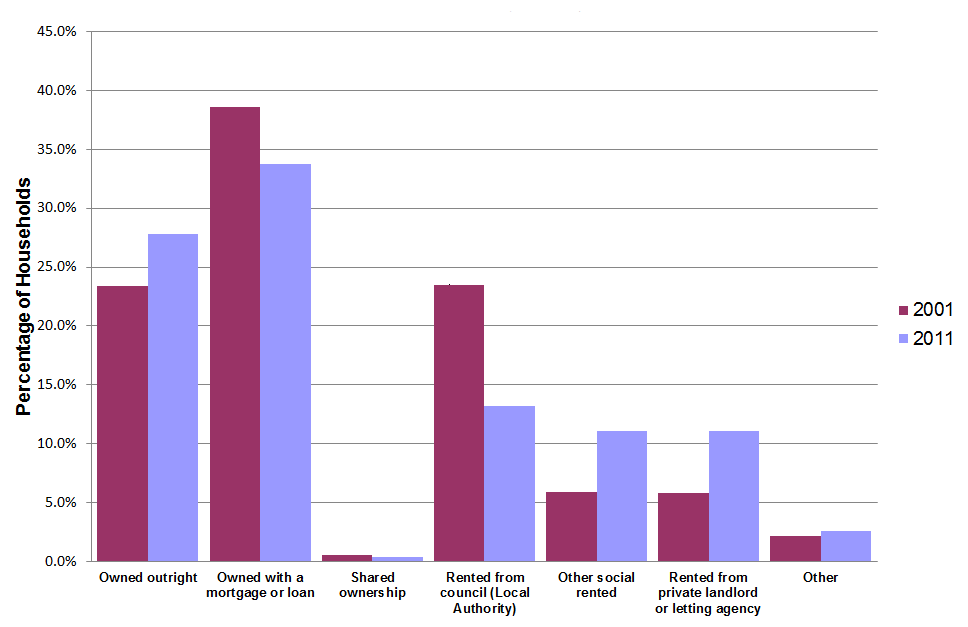
Communal establishments provide managed residential accommodation. Examples include sheltered accommodation units, student halls of residence, care homes and prisons. There were 5,425 communal establishments in Scotland at the time of the 2011 Census.
It was estimated that 1.9 per cent (99,000 people) of Scotland's population lived in communal establishments in 2011, a slight increase on the 1.7 per cent (86,000) in 2001. The proportion of people living in a communal establishment was generally higher in councils with large cities and significant student populations.
Of the people living in communal establishments at the time of the 2011 Census, 38 per cent were in education establishments such as student halls of residence, 37 per cent were in care homes and a further 6 per cent in other medical and care establishments.
Whilst still the most common status, the proportion of adults (defined as people aged 16 and over) in Scotland who are married fell by five percentage points between 2001 and 2011 (from 50 to 45 per cent). There was an increase of five percentage points (from 30 per cent to 35 per cent) in the proportion of adults who were single (never married or never registered in a civil partnership). A total of 7,000 people or 0.2 per cent of adults reported on census day that they were in registered same-sex civil partnerships.
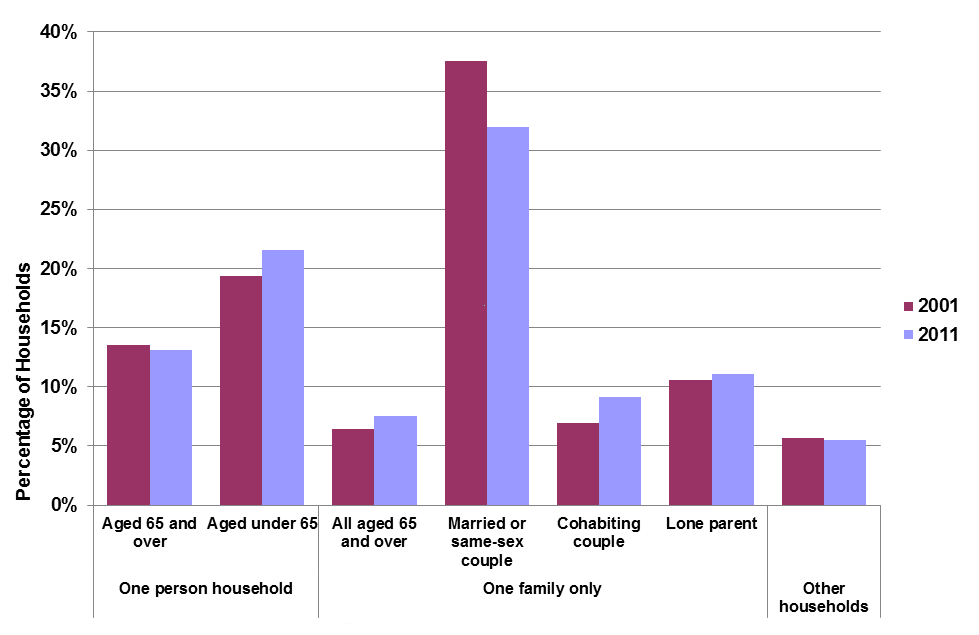
The most commonly identified household type was married or same-sex civil partnered couple families (either with or without children), which comprised almost a third (32 per cent) of households (Figure 9.6). The second most common household type was one person aged under 65 living alone (22 per cent), followed by one person aged 65 or over living alone (13 per cent). There were 263,000 lone parent family households (11 per cent of all households), of which nearly two thirds included dependent children. Nine per cent of households were cohabiting couple families, and 8 per cent were families where all persons were aged 65 or over. Since 2001, the proportion of married or same-sex civil partnered couple families fell from 38 per cent to 32 per cent of all households, whereas the proportion of cohabiting couple families rose from 7 per cent to 9 per cent.
Out of the 170,000 lone parents aged 16 to 74 with dependent children, 92 per cent (156,000) were female; this was the same proportion as in 2001. In 2011, 64 per cent of male lone parents and 58 per cent of female lone parents aged 16 to 74 were in employment. Both the proportion of lone parents in employment, and the hours worked by those in employment, increased between 2001 and 2011.
Of all the households in Scotland in 2011, just over a quarter (26 per cent) included at least one dependent child, which was a slight decrease from 28 per cent in 2001. Comparison of families with and without children shows those including married or same-sex civil partnered couples were more likely to have children than cohabiting couples (61 per cent of married or same-sex civil partnered couple families compared with 46 per cent of cohabiting couple families).
In 2011, there were 614,000 families with a total of 1.0 million dependent children. Of these families, 50 per cent (304,000) included one dependent child, 37 per cent (229,000) included two dependent children and the remaining 13 per cent (81,000) included three or more dependent children.
From the 2011 Census data, 60 per cent of households were categorised as deprived in one or more of the following dimensions: employment, education, health and housing. Thirty-two per cent of households were deprived in one dimension, 20 per cent in two dimensions, 6 per cent in three dimensions and 1 per cent in all four dimensions.
The most common dimensions for deprivation of households were education and health, either as the only dimension of deprivation (14 per cent and 11 per cent respectively of all households) or in combination with each other (12 per cent of all households).
In the 2011 Census, just over a quarter (26 per cent, 1.1 million) of the population in Scotland aged 16 and over reported they had achieved Census Level 4 or above qualifications, such as a university degree (Figure 9.7).
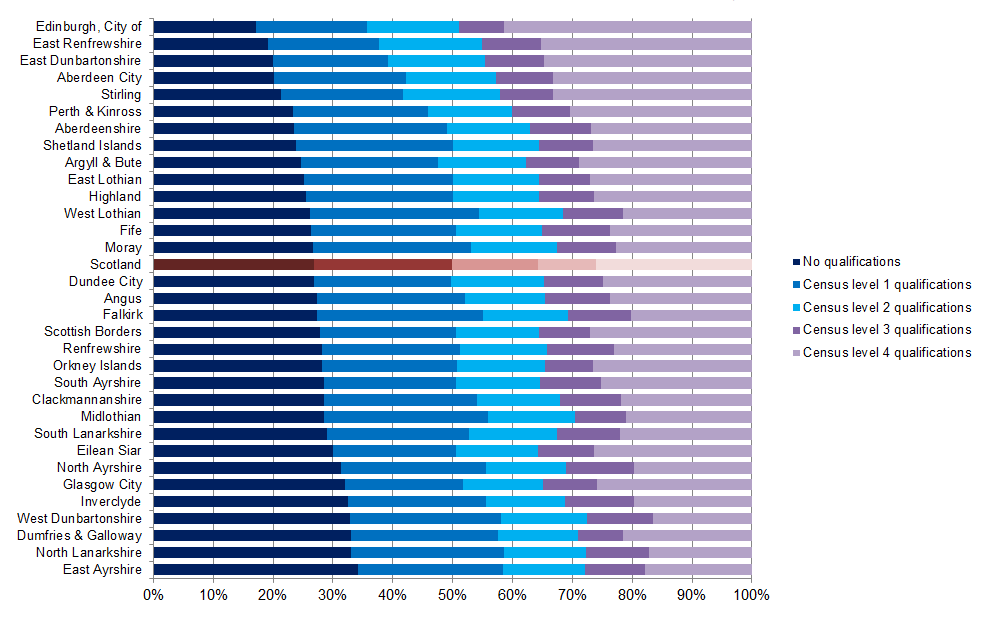
Of the 4.0 million people in Scotland aged between 16 and 74, 69 per cent (2.7 million) were economically active (either working or looking for work). The proportions of economically active males and females were 74 per cent and 64 per cent respectively.
The largest category of economically active people was full-time employees, who represented 40 per cent (1.6 million) of the total 16 to 74 year-old population, followed by part-time employees at 13 per cent (530,000). In terms of proportions, almost five times more females were part-time employees compared with males (33 per cent of economically active females compared with 7 per cent of economically active males).
Between 2001 and 2011, the proportion of economically active people aged 16 to 74 increased by four percentage points, from 65 per cent (2.4 million) in 2001 to 69 per cent (2.7 million) in 2011, with the largest increase being for part-time employees (Figure 9.8). Seven per cent (189,000) of the economically active population in Scotland aged between 16 and 74 were unemployed, excluding full-time students looking for work. This was slightly higher than the 2001 figure of 6 per cent (148,000). Retired people represented 15 per cent of all 16 to 74 year-olds, and accounted for approaching half (48 per cent) of the economically inactive in this age group.
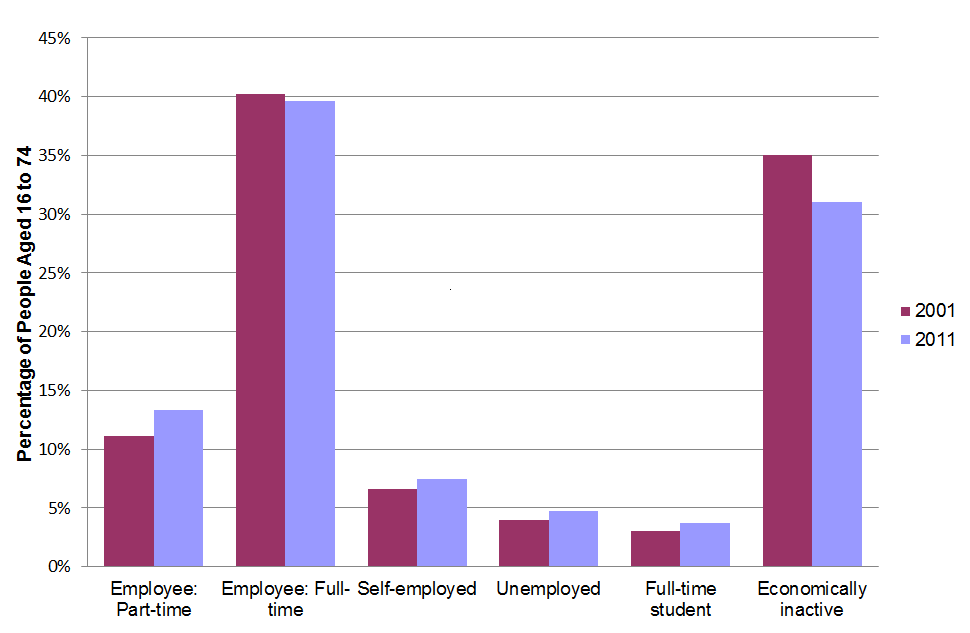
In 2011, just over half (51 per cent) of the 2.5 million employed people aged 16 to 74 in Scotland worked 38 hours or more in a typical week in their main job; 39 per cent (984,000) worked between 38 and 48 hours and 12 per cent (295,000) worked 49 hours or more.
'Health and social work' and 'Retail activities' were the two largest industry sectors in 2011 in terms of the number of employed people aged 16 to 74, each accounting for 15 per cent (377,000) of this population (Figure 9.9). Analysis of data from the 1911, 1961 and 2011 censuses highlights the marked change there has been over the last hundred years (and in particular the last 50 years) in the industry sector of employed people in Scotland. Agriculture and fishing (12 per cent) and manufacturing (35 per cent) accounted for approaching half of people in employment in 1911. However, by 2011 these sectors accounted for 10 per cent of employed people aged 16 to 74, including 8 per cent in manufacturing. In contrast the proportion of people employed in the services sector increased from 38 per cent in 1911 to 49 per cent in 1961, and then to 79 per cent in 2011. The proportion of employed people working in the Energy & Water sector (which includes mining) fell from 8 per cent in 1911 to 3 per cent in 2011, while the proportion in the construction sector was unchanged at 8 per cent.
The proportion of males working in the 'Construction', 'Manufacturing' and 'Transport and storage' sectors was much higher than the proportion of females, while there were higher proportions of females than males working in 'Health and social work' and 'Education' sectors.
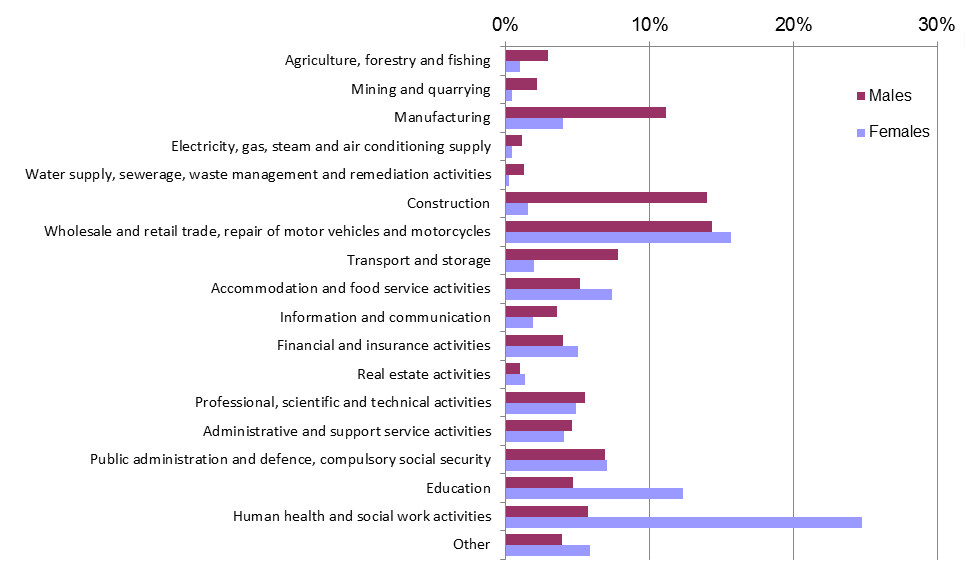
The largest category of occupation was 'Professional occupations', employing 17 per cent of all employed people aged 16 to 74. Around nine times more males than females worked in 'Skilled trades occupations' and seven times more males than females worked as 'Process, plant and machine operatives' (Figure 9.10). In contrast, around five times more females than males worked in 'Caring, leisure and other service occupations' and four times more females worked in 'Administrative and secretarial occupations'.
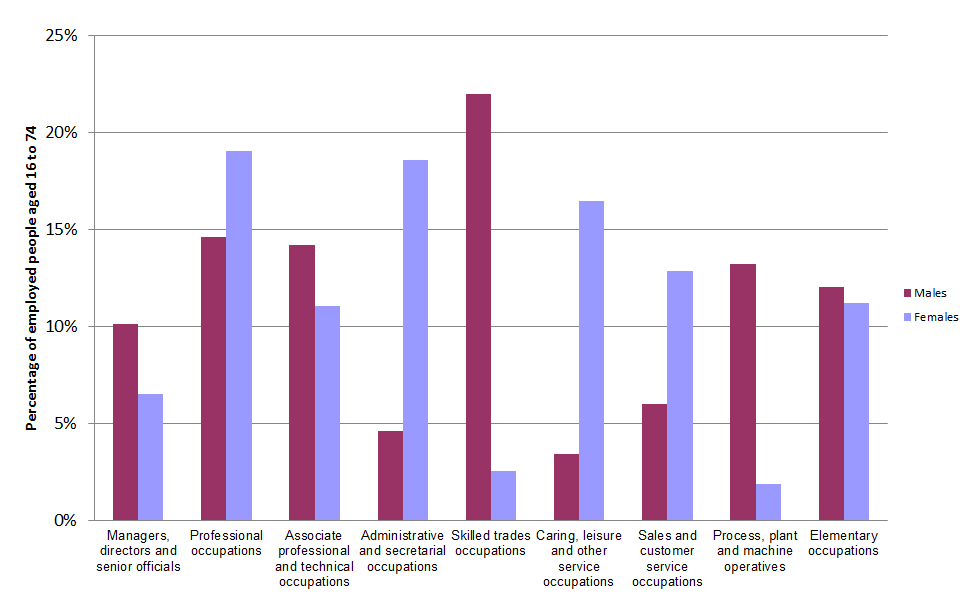
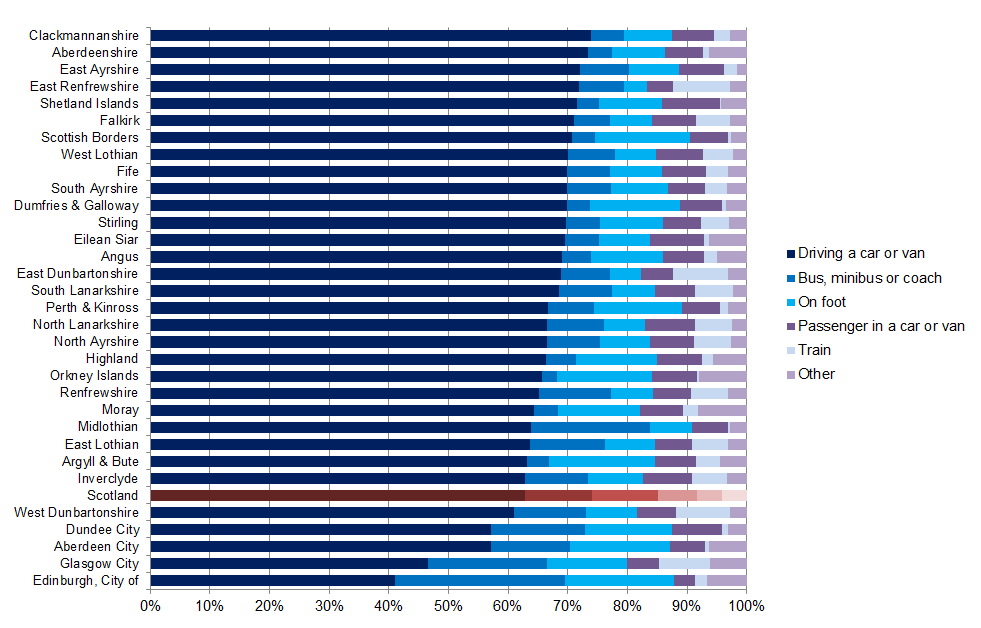
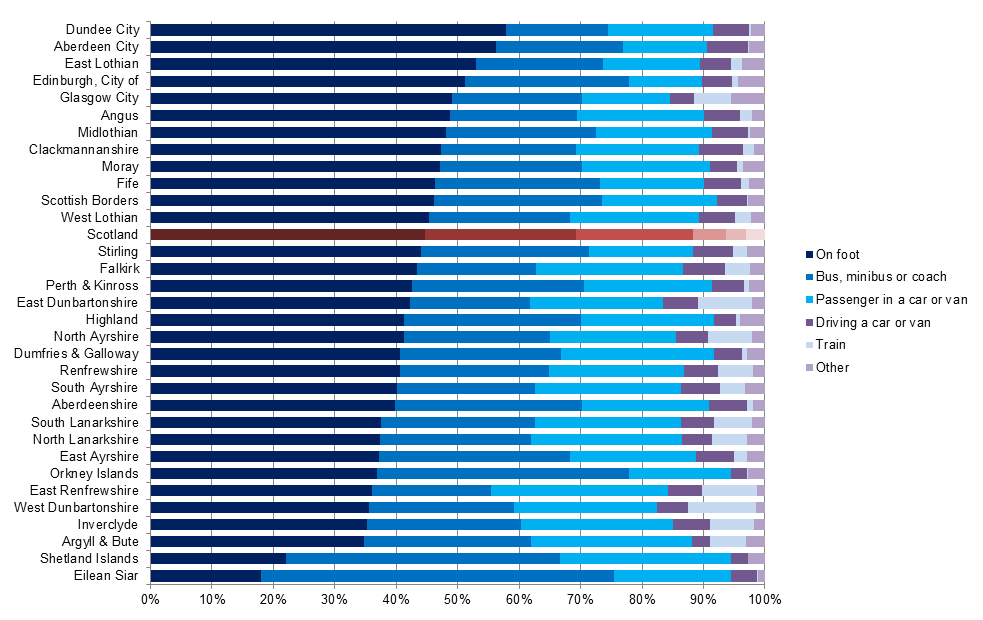
Considering just the total population of 16 to 74 year olds in employment (excluding full-time students) who travel to work, 63 per cent indicated that they drove a car or van (Figure 9.11). The corresponding proportion in 2001 was 59 per cent. Travelling on foot was the most common method of travel to study in 2011, at 45 per cent (Figure 9.12). The corresponding proportion in 2001 was 48 per cent.
As more detailed data becomes available from the 2011 Census, National Records of Scotland will continue to work with stakeholders to promote uses of the census data and ensure the value and benefits of this rich data source are realised. All of this activity will also feed into our understanding of the needs of our stakeholders enabling us to plan for the future of the census in a way that can best meet those needs. More detailed information about the 2011 Census can be found on the Scotland's Census website.